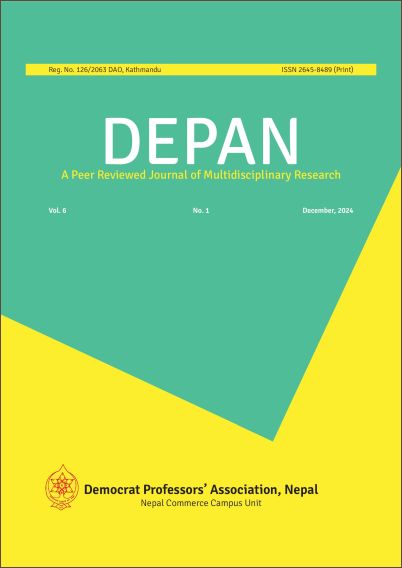Credit risk Management and Profitability: Empirical Evidence from Commercial banks in Nepal
DOI:
https://doi.org/10.3126/depan.v6i1.75475Keywords:
Capital Adequacy Ratio, Return on Assets, Non-Performing Loan, Credit Deposit RatioAbstract
The study focuses on credit risk management and the profitability of Nepalese commercial banks, using a sample of five banks Nepal SBI, Nabil, Sanima, NIC Asia, and Agricultural Development Bank Limited selected from 20 commercial banks. The primary aim is to analyze the impact and relationship between credit risk management and the profitability of these banks. The sample selection was based on judgment, covering 50 observations over ten years of annual financial data. A descriptive and causal-comparative research design was adopted. Statistical tools such as mean, standard deviation, and coefficient of variation were utilized, alongside inferential statistics like correlation, regression analysis, and hypothesis testing, to evaluate variables. Credit risk indicators, including the capital adequacy ratio, supplementary capital ratio, core capital ratio, non-performing loan ratio, credit deposit ratio, and cash reserve ratio, were analyzed as independent variables. Profitability measures, such as return on equity and return on assets, served as dependent variables. The study concluded that return on equity is positively related to the capital adequacy ratio and non-performing loan ratio, indicating a direct relationship. However, it is negatively associated with the supplementary capital ratio, core capital ratio, credit deposit ratio, and cash reserve ratio. Similarly, return on assets showed a positive correlation with the capital adequacy ratio, core capital ratio, non-performing loan ratio, credit deposit ratio, and cash reserve ratio, but a negative correlation with the supplementary capital ratio.
Downloads
Downloads
Published
How to Cite
Issue
Section
License

This work is licensed under a Creative Commons Attribution 4.0 International License.
This license enables reusers to distribute, remix, adapt, and build upon the material in any medium or format, so long as attribution is given to the creator. The license allows for commercial use.




